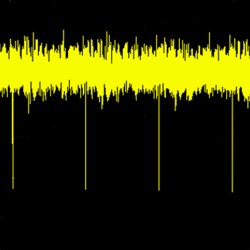The Dark Side of LasersSome scientific discoveries completely change how we look at things: it certainly was the case for Dirac’s theory on antimatter or Einstein’s theory of relativity. Now, our existing scientific ideas are set to change once more; new experiments show that laser theory should be extended to include dark pulse emission.
 Dark pulse emission. Dark pulses appear as intensity dips in a continuous light emission, as opposed to bright pulses, which are intense bursts of light.
The analogy between matter physics and optics may sound a bit far-fetched at first glance, but, as Randall J. Knize at the United States Air Force Academy (USAFA, Colorado, USA) says, "the experiment at NTU is a very surprising result that follows in the steps of Dirac's prediction of antimatter." Let us proceed step by step.
What is a light pulse? Once the working principle of a laser is understood, this concept follows easily. In the simplest picture, a standard laser comes about by placing an amplifying material between two mirrors, hereby forming a cavity. Any amplifying material usually works for a whole range of light wavelengths, but only some, called longitudinal modes, get amplified while bouncing back and forth across the cavity. These modes are usually independent, like many different lasers all working independently from each other. In a laser with thousands of modes, therefore, the output intensity is an average among all the modes and looks almost constant (continuous wave). If the modes are all forced to oscillate synchronously, the output intensity is an intense burst of light and the laser is said to be mode-locked. These bursts are called bright pulses and periodically increase the brightness of the laser emission for a very short time.
What is a dark light pulse then? A dark pulse is an intensity dip in a continuous light emission. "In analogy to bright pulses, which instantaneously focus light, yielding high intensities," Carl O. Weiss at the Physikalisch-Technische Bundesanstalt (PTB, Braunschweig, Germany) comments, "dark pulses can be thought of as focusing the vacuum. As the peak-to-background intensity ratio can achieve dramatic numbers in bright pulses, so can the focused-to-unfocused vacuum ratio in dark pulses."
"We came to this idea," Dingyuan Tang at NTU explains, "as a natural consequence of our research on the bright soliton fiber lasers." Solitons are light pulses which maintain their shape while traveling in a medium, such as an optical fiber, at a constant speed. They can be either bright or dark. "The bright optical soliton formation in the single mode optical fibers," Tang adds, "is described by the nonlinear Schroedinger equation, a paradigm equation of the soliton study. For the same equation it was also theoretically predicted that dark solitons could be formed and they were eventually experimentally confirmed for light propagation in single mode fibers [1]. However, to the best of my knowledge, it has not been observed in any lasers." Until now! Weiss further explains that "as particles are simple structures in the quantum field, so are solitons in the optical field. This work shows also here, for the dark and bright pulses, the particle/antiparticle picture."
Solitons received great attention in telecommunications until a decade ago because of their inherent stability, which suggested the possibility of having long-distance communications through fibers without the use of repeaters. Leaving communications aside, Tang believes that these results on the dark pulse formation "could be useful in areas like optical signal processing, optical sensing, bio-research and atomic trapping." He adds: "We are going to work with other groups to explore the possible applications of the laser emission. After our paper was published, several people working in the areas of optical communication, atomic trapping, and fiber optical sensors have contacted us for the possibility of using our dark light source in their systems."
Tang and coworkers’ results also arise great interest from a fundamental point of view because they are not described by the conventional laser theory. As Tang explains, "our experimental results clearly show that a laser can exhibit a lot of new features once the effects of nonlinear light propagation play a role. The conventional laser theory cannot describe these new laser features at the moment. This year is the 50th anniversary of the laser invention. Although in the past 50 years lasers have revolutionized the modern science and technology, the research on lasers is not over yet." Knize agrees with Tang that "based on the conventional laser mode-locking theory, the appearance of dark pulses is surprising and strange. Standard theory describes bright pulses in mode-locked lasers. In a broader sense, it is a complementary state to the conventional mode-locked laser state, just like anti-matter positive charged positrons are to the normal negative charged electrons." Closing the loop with Dirac’s prediction, it took a number of years before physicists could fully understand it and eventually discover the predicted positron. As Knize concludes, "we do not know where Tang and coworkers’ work will lead, but it is surely an interesting result in laser physics."
[1] P. Emplit et al., Picosecond Steps and Dark Pulses through Nonlinear Single Mode Fibers, Opt. Commun. 62, 374-379 (1987).
Giorgio Volpe2010 © Optics & Photonics FocusGV is currently working on his doctoral thesis at ICFO - The Institute of Photonic Sciences, Barcelona (Spain). |
|